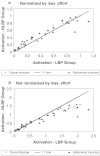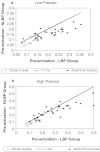Trunk muscular activation patterns and responses to transient force perturbation in persons with self-reported low back pain
- PMID: 15906102
- PMCID: PMC3489343
- DOI: 10.1007/s00586-005-0893-7
Trunk muscular activation patterns and responses to transient force perturbation in persons with self-reported low back pain
Abstract
Trunk stability requires muscle stiffness associated with appropriate timing and magnitude of activation of muscles. Abnormality of muscle function has been implicated as possible cause or consequence of back pain. This experimental study compared trunk muscle activation and responses to transient force perturbations in persons with and without self-reported history of low back pain. The objective was to determine whether or not history of back pain was associated with (1) altered anticipatory preactivation of trunk muscles or altered likelihood of muscular response to a transient force perturbation and (2) altered muscle activation patterns during a ramped effort. Twenty-one subjects who reported having back pain (LBP group) and twenty-three reporting no recent back pain (NLBP group) were tested while each subject stood in an apparatus with the pelvis immobilized. They performed 'ramped-effort' tests (to a voluntary maximum effort), and force perturbation tests. Resistance was provided by a horizontal cable from the thorax to one of five anchorage points on a wall track to the subject's right at angles of 0 degrees, 45 degrees, 90 degrees, 135 degrees and 180 degrees to the forward direction. In the perturbation tests, subjects first pulled against the cable to generate an effort nominally 15% or 30% of their maximum extension effort. The effort and the EMG activity of five right/left pairs of trunk muscles were recorded, and muscle responses were detected. In the ramped-effort tests the gradient of the EMG-effort relationship provided a measure of each muscle's activation. On average, the LBP group subjects activated their dorsal muscles more than the NLBP group subjects in a maximum effort task when the EMG values were normalized for the maximum EMG, but this finding may have resulted from lesser maximum effort generated by LBP subjects. Greater muscle preactivation was recorded in the LBP group than the NLBP group just prior to the perturbation. The likelihood of muscle responses to perturbations was not significantly different between the two groups. The findings were consistent with the hypothesis that LBP subjects employed muscle activation in a quasi-static task and preactivation prior to a perturbation in an attempt to stiffen and stabilize the trunk. However, interpretation of the findings was complicated by the fact that LBP subjects generated lesser efforts, and it was not known whether this resulted from anatomical differences (e.g., muscle atrophy) or reduced motivation (e.g., pain avoidance).
Figures




Similar articles
-
Individuals with non-specific low back pain in an active episode demonstrate temporally altered torque responses and direction-specific enhanced muscle activity following unexpected balance perturbations.Exp Brain Res. 2012 Sep;221(4):413-26. doi: 10.1007/s00221-012-3183-8. Epub 2012 Aug 9. Exp Brain Res. 2012. PMID: 22875027 Free PMC article.
-
Decrease in trunk muscular response to perturbation with preactivation of lumbar spinal musculature.Spine (Phila Pa 1976). 2000 Aug 1;25(15):1957-64. doi: 10.1097/00007632-200008010-00015. Spine (Phila Pa 1976). 2000. PMID: 10908940
-
The association of low back pain, neuromuscular imbalance, and trunk extension strength in athletes.Spine J. 2006 Nov-Dec;6(6):673-83. doi: 10.1016/j.spinee.2006.03.012. Spine J. 2006. PMID: 17088198
-
Anticipatory and compensatory postural adjustments in people with low back pain: a systematic review and meta-analysis.Spine J. 2018 Oct;18(10):1934-1949. doi: 10.1016/j.spinee.2018.06.008. Epub 2018 Jun 12. Spine J. 2018. PMID: 29906616
-
Classification of paraspinal muscle impairments by surface electromyography.Phys Ther. 1998 Aug;78(8):838-51. doi: 10.1093/ptj/78.8.838. Phys Ther. 1998. PMID: 9711209 Review.
Cited by
-
Individuals with non-specific low back pain in an active episode demonstrate temporally altered torque responses and direction-specific enhanced muscle activity following unexpected balance perturbations.Exp Brain Res. 2012 Sep;221(4):413-26. doi: 10.1007/s00221-012-3183-8. Epub 2012 Aug 9. Exp Brain Res. 2012. PMID: 22875027 Free PMC article.
-
Neuromuscular adaptations after a rehabilitation program in patients with chronic low back pain: case series (uncontrolled longitudinal study).BMC Musculoskelet Disord. 2013 Sep 24;14:277. doi: 10.1186/1471-2474-14-277. BMC Musculoskelet Disord. 2013. PMID: 24063646 Free PMC article.
-
A history of low back pain associates with altered electromyographic activation patterns in response to perturbations of standing balance.J Neurophysiol. 2011 Nov;106(5):2506-14. doi: 10.1152/jn.00296.2011. Epub 2011 Jul 27. J Neurophysiol. 2011. PMID: 21795622 Free PMC article.
-
Ultrasound evidence of altered lumbar connective tissue structure in human subjects with chronic low back pain.BMC Musculoskelet Disord. 2009 Dec 3;10:151. doi: 10.1186/1471-2474-10-151. BMC Musculoskelet Disord. 2009. PMID: 19958536 Free PMC article.
-
Altered postural responses persist following physical therapy of general versus specific trunk exercises in people with low back pain.Man Ther. 2014 Oct;19(5):425-32. doi: 10.1016/j.math.2014.04.007. Epub 2014 Apr 24. Man Ther. 2014. PMID: 24853255 Free PMC article. Clinical Trial.
References
-
- Alexiev AR. Some differences of the electromyographic erector spinae activity between normal subjects and low back pain patients during the generation of isometric trunk torque. Electromyogr Clin Neurophysiol. 1994;34(8):495–499. - PubMed
-
- Bergmark A. Stability of the lumbar spine. A study in mechanical engineering. Acta Orthop Scand Suppl. 1986;230:1–54. - PubMed
-
- Cassisi JE, Robinson ME, O’Conner P, MacMillan M. Trunk strength and lumbar paraspinal muscle activity during isometric exercise in chronic low-back pain patients and controls. Spine. 1993;18(2):245–251. - PubMed
Publication types
MeSH terms
Grants and funding
LinkOut - more resources
Full Text Sources
Other Literature Sources
Medical
Miscellaneous

